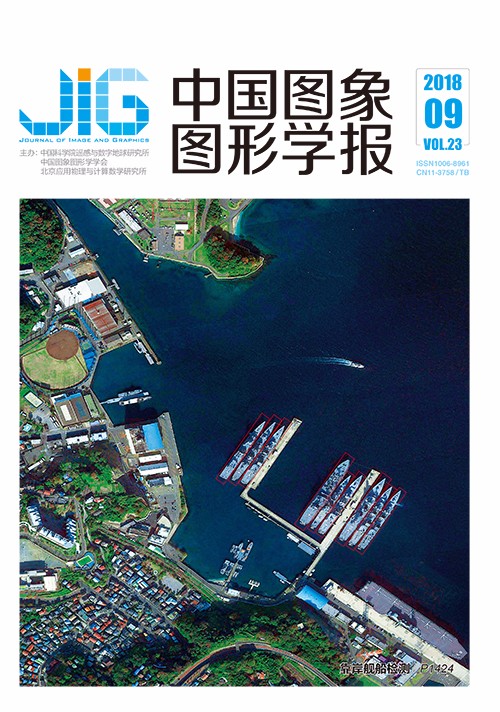
模糊相关图割的非监督层次化彩色图像分割
摘 要
目的 基于阈值的分割方法能根据像素的信息将图像划分为同类的区域,其中常用的最大模糊相关分割方法,因能利用模糊相关度量划分的适当性,得到较好的分割结果,而广受关注。然而该算法存在划分数需预先确定,阈值的分割结果存在孤立噪声,无法对彩色图像实施分割的问题。为此,提出基于模糊相关图割的非监督层次化分割策略来解决该问题。方法 算法首先将图像划分为若干超像素,以提高层次化图像分割的效率;随后将快速模糊相关算法与图割结合,构成模糊相关图割2-划分算子,在确保分割效率的基础上,解决单一阈值分割存在孤立噪声的问题;最后设计了自顶向下层次化分割策略,利用构建的2-划分算子选择合适的区域及通道,迭代地对超像素实施层次化分割,直到算法收敛,划分数自动确定。结果 对Berkeley分割数据库上300幅图像进行了测试,结果表明算法能有效分割彩色图像,分割精度优于Ncut、JSEG方法,运行时间较这两种方法也提高了近20%。结论 本文算法为最大模糊相关算法在非监督彩色图像分割领域的应用提供指导依据,能用于目标检测和识别领域。
关键词
Unsupervised hierarchical color image segmentation through fuzzy correlation and graph cut
Yin Shibai1, Kong Chuihan1, Wang Yibin2(1.Department of Economic Information Engineering, Southwestern University of Finance and Economics, Chengdu 611130, China;2.Department of Engineering, Sichuan Normal University, Chengdu 610101, China) Abstract
Objective Image segmentation is a process of dividing an image into different regions such that each region is homogeneous but the union of any two adjacent regions is not. As the first step in image analysis and pattern recognition, image segmentation serves as a fundamental step in numerous computer vision applications, such as object detection, content-based image retrieval, and medical image analysis. Threshold-based methods, which subdivide the image into several homogenous regions on the basis of pixel intensities, are popular segmentation techniques. Numerous algorithms have been proposed in this direction, which include gray-level thresholding and interactive pixel classification. Among these algorithms, the frequently used maximum fuzzy correlations are widely adopted to measure the appropriateness of fuzzy two partitions for the image segmentation purpose due to the unavoidable ambiguities, fuzziness, and uncertainty of the image information. However, this method has some limitations, i.e., the partition number needs to be preset, the results have isolated noise, and maximum fuzzy correlation approach cannot be extended to color image segmentation. Method Most existing gray-level image segmentation techniques could be extended to color image. They can be directly applied to each component of a color space, and then, the result can be combined in a certain way to obtain the final segmentation result. However, one of the problems is how to use the color information as a whole for each pixel and how to select the color representation for segmentation because each color representation has advantages and disadvantages. To address these problems, an unsupervised hierarchical color image segmentation through maximum fuzzy correlation and graph cut is proposed. First, we oversegment the color image into superpixels to improve the efficiency of hierarchical image segmentation. Then, we combine the fast fuzzy correlation with graph cut to form a bi-level segmentation operator, which can suppress the isolated noise caused by the single threshold-based approach and enforce the spatial coherence in the thresholding segmentation approach. Here, an iterative calculation scheme is presented to reduce redundant computations in fuzzy correlation evaluation. Finally, a top-down hierarchical segmentation approach has been designed. By iteratively performing this bi-level segmentation operator, multilevel image segmentation is achieved in a hierarchical manner. Starting from the input color image, our algorithm first selects the color channel that can best segment the image into two labels and then iteratively selects channels to further split each label until convergence. In practice, we partition the 3D color space and adopt the idea of k-d tree to record the segmentation process. Result The presented hierarchical segmentation is implemented in Matlab 7.0. Quantitative and qualitative evaluations are performed to compare with those from the state-of-the-art methods. To test the effectiveness of graph cut on the basis of two fuzzy correlation partitions, we compare our method with maximum fuzzy correlation. The experiment shows that our method can overcome the isolated noise and obtain satisfactory results. To demonstrate the segmentation performance of our algorithm on the color images, the Berkeley segmentation database is used, which consists of 300 natural images of diverse scene categories. We quantitatively compare the performance of our method with existing SAS, Ncut, and JSEG methods. Among these methods, SAS and Ncut are semi-supervised hierarchical superpixel-based color image segmentation methods. However, JSEG is an unsupervised color image segmentation method. By utilizing four widely used metrics, we can find that our method outperforms the Ncut and JSEG methods in terms of precision, and the running time is improved by 20%. Compared with SAS, our method obtains subpar results because it uses only pixel color information and is fully unsupervised. In comparison, the SAS approach uses high-level features, such as texture, edges, and color for segmentation. Conclusion An unsupervised hierarchical image segmentation approach is presented in this paper. The algorithm uses superpixels as segmentation primitives and iteratively partitions all superpixels using a bi-level segmentation operator, which combines fuzzy correlation and graph cut. By using this scheme, the proposed method can effectively handle color images and provide an important reference for the application of the maximum fuzzy correlation algorithm in the field of unsupervised color image segmentation. The limitation of the proposed approach is that it only segments images by using color information, which leads to suboptimal results when the objects and background have similar colors. Utilizing high-level cues in the proposed hierarchical segmentation framework while maintaining it as an unsupervised approach is a non-trivial task. We plan to study this issue as part of our future work.
Keywords
|



 中国图象图形学报 │ 京ICP备05080539号-4 │ 本系统由
中国图象图形学报 │ 京ICP备05080539号-4 │ 本系统由